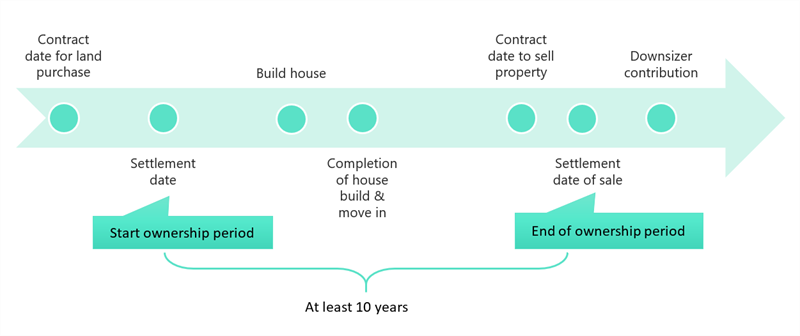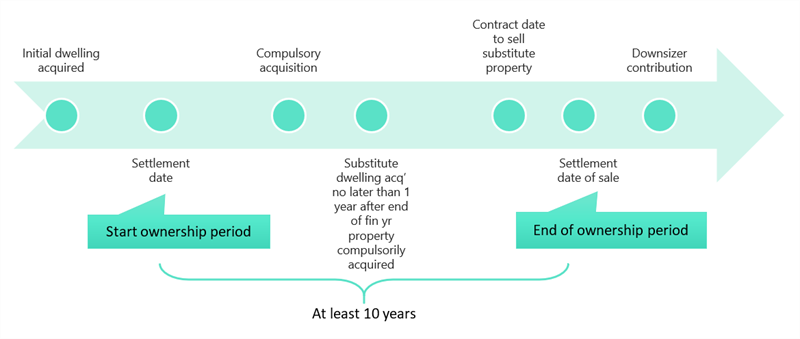

In my previous article on Downsizer contributions, I briefly discussed the Government’s announcement of reducing the downsizer eligibility age further to age 55. Since then, Treasury Laws Amendment (2022 Measures No. 2) Bill 2022 has been introduced to Parliament to legislate the change. At the time of writing, the Bill has not progressed from the House of Representatives and is yet to be considered in the Senate.
Should the proposed amendment pass both houses and receive Royal Assent, the change will come into effect from the 1st of the month, after the quarter in which it receives Royal Assent. That is, in the unlikely event Royal Assent is received before the end of September, the change will commence from 1 October. If it is the December quarter in which Royal Assent is received, then it will be 1 January 2023 that the change will be effective from, and so on and so for.
In this instalment of reviewing the Downsizer provisions, I want to explore beyond the basic eligibility criteria and address some of the other areas that come up in conversation from time to time.
Although splitting an asset may result in the creation of new assets, the splitting itself is not a CGT event. Any subsequent disposal of the new assets will likely be a CGT event and the catalyst for Downsizer consideration.
The creation of the new assets, because of the subdivision, does not result in a reset of the ownership period. This is on the assumption that there is no change in beneficial owners from the original asset to the new assets. Therefore, when considering the 10-year ownership requirements, the period that both the original and new assets were held can be considered.
The other factor to consider when disposing of the new asset is what is being disposed of? The Downsizer provisions require the disposal of a dwelling that is your main residence. Selling the subdivided vacant lot on its own, will not satisfy this condition.
Nor will selling a newly built house on the subdivided block if you are unable to apply a partial of full main residence CGT exemption on the sale. Moving into the new house and selling the original dwelling may, subject to meeting all other criteria, allow you to make a downsizer contribution.
The 10-year ownership condition may be satisfied if you, your spouse or your former spouse held an ownership interest in the land the dwelling is situated on for at least the required time.
This may allow you to acquire a vacant property, build on it sometime later, and still satisfy the 10-year rule. That is, you do not necessarily need to own the dwelling for the 10-year period. Consider the below graphic as a visual example of how this may work.

As alluded to above, the ownership of the interest can be linked to you, your spouse or your former spouse. In circumstances where a couple may separate and go through a property settlement, this may prove useful when the dwelling is sold.
Consider older clients that are from a time when it was common practice for properties to be held in the name of the husband only. Suppose they, or anyone else in a similar situation, happen to separate, and the spouse ends up with the property. In that case, the 10-year ownership period will be calculated from when the original owner gained possession to when the subsequent owner disposed of the dwelling.
Where a property may transfer from one spouse to another due to the original owner's passing, the 10-year ownership period will work in the same way. That is, the ownership period of both spouses will be included when determining the length of time the interest was held.
This will also include any periods during which the trustee of the deceased estate may have held the property. Under the Downsizer provisions, any period the deceased estate’s trustee holds the interest will be treated as if the original individual held it.
This may be beneficial in circumstances where the trustee of the estate disposes of the property and provides the proceeds to the spouse.
In the situation where the property is transferred from the estate to the spouse, the spouse is taken to have acquired the property on the day the deceased spouse died. In this circumstance, there is a clear continuation of ownership from one spouse to the other.
Although not as common, another area where a transfer of a dwelling may occur within the family is where the parents may gift or sell the house to their children, often at less than market value.
Under market substitution rules, capital gains legislation requires an asset's market value to be considered when an asset is disposed of at less than its market value. When the downsizer rules were first introduced, it was thought by some that the proceeds that could potentially be contributed to super would be the higher amount, based on the market substitution provisions.
Unfortunately for those who attempted to take advantage of this, the downsizer legislation specifically disregards the market substitution rules when determining the amount that may be contributed to super. The amount that may potentially be contributed is the lesser of $300,000 or the capital proceeds received. Using a higher disposal value under the market substitution rules, for capital gains purposes, does not increase the proceeds received for downsizer purposes.
Another lesser-known provision of the downsizer rules is the substitute property provisions. Where a property has been compulsorily acquired, lost or destroyed and is replaced with another property that can be treated as your main residence, the ownership period may, in certain circumstances, be measured against both dwellings.
In my home state of South Australia, large stretches of South Road have been updated to accommodate the north-south transport corridor. This has resulted in many homes being compulsorily acquired by the Government. I assume similar projects have and will continue to occur in other parts of the country.
Provided you acquire an interest in a new property within one year, after the end of the income year in which the old property was compulsorily acquired, lost or destroyed, the ownership period may be measured against both properties. Consider the below graphic as a visual example of how this may work.

Similar rules may also be applied where a dwelling is lost or destroyed, i.e. in a fire or flood. Situations that have impacted many people over recent years.
When discussing the idea of subdividing a property above, I mentioned the requirement for a dwelling to be disposed of to consider the main residence CGT exemption rules. Where a dwelling has been accidentally destroyed, and the land is subsequently sold, it may still be possible to treat the land as your main residence from the time of destruction to the time your ownership interest ends. You may be able to choose to apply the main residence exemption rules as if the dwelling had not been destroyed and was still your main residence.
The basic eligibility criteria for making a downsizer contribution may seem relatively straightforward in the majority of cases. However, the interaction of the various aspects of the CGT main residence exemption means further consideration will need to be investigated before it can be determined whether someone will be eligible or not. If in doubt, seeking professional advice will allow you to better understand whether you may be eligible to make a downsizer contribution.